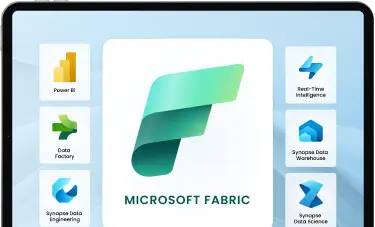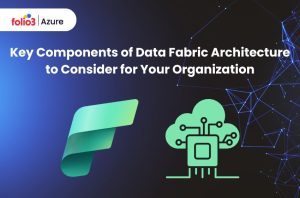Table of Contents
ToggleMartina Navratilova truthfully says, “Security used to be an inconvenience sometimes, but now it’s a necessity all the time.”
Companies need to protect their data continuously and rigorously. As more and more companies are reverting from on-premise to cloud-based system owing to the exponential rise in data volume, securing the endpoints has become a necessity.
Talking of endpoints, let’s gain some clarity: a private endpoint is a network interface that uses a private IP address from your virtual network.
Using private endpoints with Microsoft Fabric is one of the strongest tools for safeguarding your cloud environment. It increases your organization’s security and guarantees that sensitive data stays within your network.
Let’s see how private endpoints work, their benefits, and how to configure them within Microsoft Fabric for ultimate protection.
Using private endpoints with Microsoft Fabric lets you create secure, private connections that safeguard your data and lower security risks. Whether you are handling sensitive business information or critical workloads, private endpoints warrant that your infrastructure remains protected from external threats.
Accelerate smart decisions with Microsoft Fabric's unified data and AI analytics.

Understanding Private Endpoints
Private endpoints are specialized network interfaces that safely connect to Azure services like storage accounts or data factories without exposing them to the public internet. This is vital for organizations that manage susceptible data because it guarantees that all communications between your resources stay private within a virtual network (VNet).
Private endpoints for Microsoft Fabric facilitate services’ securely connecting via Azure Private Links, thus providing direct access to resources while bypassing public exposure.
Managed private endpoints let you control these connections fully. This way, only authorized services and users can gain access. With the added layer of security from private endpoints, you can be at peace knowing that your resources are protected from unauthorized access.
One of the core benefits of private endpoints is reducing data exposure. By keeping your services within your VNet, you minimize exposed areas of your infrastructure. This lowers the risk of cyberattacks. Moreover, this feature ensures compliance with industry regulations, guaranteeing that sensitive data is safe against unauthorized access.
Adding on, private endpoints for Microsoft Fabric integrate easily with many Azure services, such as Azure Storage and Azure SQL, enabling you to improve security in your cloud environment.
How to Set Up Private Endpoints in Microsoft Fabric
Now that you understand the importance of private endpoints let’s discuss how to set them up in Microsoft Fabric. Proper configuration is essential to protecting your infrastructure.
1. Configuring Network Settings
The initial step in setting up private endpoints consists of configuring your virtual network (VNet). You’ll have to create a VNet that contains all the resources that you want to secure. Once your VNet is created, configure private DNS zones to allow your services to resolve private IP addresses.
- Create Your VNet: You can start by going to your Azure portal and selecting networking services to create a new VNet. You must establish that all resources that you want to protect are included in this network.
- Configure Private DNS Zones: Ensure that your DNS settings allow private DNS resolution so that the traffic between services stays within the private network. This limits data from transmitting to the public internet, thus increasing its security.
- Add a Private Endpoint: After your VNet and DNS settings are all set, you must create a private endpoint for the resources that you want to secure. To do this, you can create a private endpoint storage account or configure a managed private endpoint data factory.
2. Establishing Connections
After configuring your network, you must start setting up connections between services using managed private endpoints. By setting up private endpoints for Microsoft Fabric, you can guarantee that all traffic between your services remains within the secure limits of your VNet.
3. Create and Delete Managed Private Endpoints
As you set up connections, you must create and delete managed private endpoints to control which services are accessible through the private connection. Managed private endpoints let you dynamically manage access to your resources, guaranteeing that only authorized services and users can connect.
4. Ensure Private Connections to Critical Resources
It’s important to link all essential Azure resources, such as your private endpoint storage account or other vital services, to your private endpoint. This way, sensitive data will always be kept secure.
5. Managing Access
To completely secure your private endpoints, managing access is important. This can be done using network security groups (NSGs) and firewalls to control traffic. By carefully managing access, you can mitigate the risk associated with unauthorized users accessing your resources.
- Utilize NSGs: Network security groups let you control which IP addresses and services can access your resources through private endpoints. This acts as an additional layer of security, preventing access of unauthorized users to your services.
- Configure Firewalls: Configure firewalls to block any unauthorized traffic. This adds another layer of security by preventing unwanted traffic from accessing your services. Combining NSGs and firewalls creates a powerful defense system that protects your infrastructure from malicious attacks.
Carefully managing access through these security tools guarantees that your services are always safe from unauthorized traffic and lets you enjoy a secure cloud environment.
Utilizing Private Endpoints for Improved Security
The most significant advantage of using private endpoints in Microsoft Fabric is securing your services from public exposure. Reducing exposure is important in today’s risky environment, where cyberattacks are becoming more sophisticated daily.
Managed private endpoints help secure data ingestion processes, protecting sensitive workloads like customer data or financial transactions. Whether dealing with an Azure private endpoint for a storage account or a complex managed private endpoint data factory, you can be assured that your sensitive information is safe.
Private endpoints protect data and work with other security mechanisms, such as encryption and identity management. Encryption warrants that even if data is intercepted, it cannot be read without the decryption keys. On the other hand, identity management tools, such as Azure Active Directory, provide role-based access control (RBAC), guaranteeing that only authorized users can interact with the private endpoints.
Another notable benefit is that private endpoints help you comply with industry standards. Keeping your data within your VNet and using tools like firewalls and encryption lets you adhere to regulatory requirements such as GDPR or HIPAA. This proactive method helps reduce the risk of hefty fines due to non-compliance.
Moreover, reducing public exposure can avoid many costs of securing public-facing endpoints. Private endpoint costs are usually lower than maintaining the same level of security for public endpoints, making them a cost-effective solution for organizations trying to improve security within their budget.
Best Practices for Private Endpoint Configuration
Some best practices ensure the best security and performance when configuring private endpoints for Microsoft Fabric. Such as the following:
1. Properly Configure DNS Settings
Ensure that private DNS zones are correctly set up to resolve all the necessary addresses within your VNet. This ensures that services can communicate internally without using public DNS servers, keeping your data secure.
2. Monitor Network Traffic
Monitor all network traffic that passes through your private endpoints using NSGs and firewalls. This will detect suspicious activity or unauthorized access attempts and allow you to respond quickly to threat data.
3. Implement Role-Based Access Control (RBAC)
With RBAC, you can restrict who can access and configure private endpoints. Limiting access reduces the risk of accidental or malicious changes to your security settings.
4. Regularly Audit Configurations
Review your private endpoint costs, access settings, and firewall rules frequently to guarantee that your configurations are always secure and following your organization’s policies and security needs.
By adopting these best practices, you can secure your private endpoints for Microsoft Fabric, protect your data, and ensure your services perform at their best.
Conclusion
In today’s cloud-based data world, where malware and attackers are ready to misuse your data, securing your infrastructure is the top priority. Using private endpoints with Microsoft Fabric provides a strong layer of security, protecting your data and critical workloads and assuring compliance with industry standards.
Whether you’re securing an Azure private endpoint for a storage account or a complex data factory, private endpoints are the most suitable and secure solution.
If you want to strengthen your cloud security, setting up private endpoints in Microsoft Fabric is necessary. We provide the tools and expertise to help you stay proactive in security. So, are you all set to boost your cloud security? Learn more and explore the full range of Microsoft Fabric services by visiting us at Folio3 Azure.


